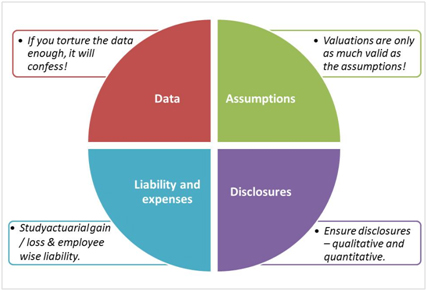4 things you must ensure in Actuarial Valuations
From the Actuary's Desk
4 things you must ensure / check in Actuarial Valuations
Actuarial valuations of employee benefits may not always be straight forward, in particular when the employee base is large or when the assumptions are changing. Having experienced actuarial valuations, here are 4 things which in my experience, a finance controller or an auditor must check / ensure in actuarial valuations of employee benefits:

1. Data Quality
If you torture the data enough, it will confess. And that is precisely what one needs to do before using any data for any purpose. Actuarial valuations are no exception.
Although the data used in actuarial valuations is usually the basic employee data, we observe that almost 50% of the cases have some sort of a data error (material or otherwise). Thus, I strongly suggest that following simple hygiene checks be carried out to ensure data provided for actuarial valuation is correct:
• Data completeness checks: Completeness of data is the extent to which the expected attributes of data are provided. Employee data provided for valuation is considered as complete if:
- Data of all employees has been provided.
- For each employee, all required information has been provided.
• Data accuracy checks: These checks consider whether the data values stored for an object are the correct values. There are two characteristics of accuracy: form and content. Form is important because it eliminates ambiguities about the content.
Accuracy checks are very important as they can have significant impact on the liability. For example, in one of the valuation, the date of joining was given incorrectly for certain employees resulting in incorrect calculation of completed years of service for those employees and hence incorrect valuation.
• Data consistency checks: Consistency of data here means that data provided for opening and closing actuarial valuations should be in synch with each other. If the same is not true, movements in liability can arise that may not be explainable.
For example, if the opening and closing salary details do not talk to each other at an employee level, one would get movements in liability that will not be explainable. We have seen this happen practically in many cases.
2. Appropriateness of Assumptions
The results of an actuarial valuation are going to be only as much valid as the assumptions. It is therefore imperative that enough attention is paid to assumptions used in actuarial valuations.
Some assumptions are of course more crucial than others (based on their potential impact on liability) and hence must be given more attention. For example, in a gratuity valuation, the salary growth rate is typically more important than the attrition rate which is typically more important than the mortality rate. In a pension or post-retirement medical benefit valuation, however, the mortality rate or the medical cost inflation becomes much more important as it impacts the number of years for which the pension / medical benefit will be payable after retirement.
The importance of any assumption can be determined by considering the sensitivity of the liability to change in assumptions, information typically included in actuarial valuation reports.
3. Liability (including movement analysis) and Expenses
Once you get the inputs (data and assumptions) right, the valuation results (i.e. the liability and the expenses) should ideally come right. However, to gain complete control and confidence over the numbers, one must see if the liability (and consequently expenses) is in line with the expectations. The same can be ensured by giving a close look at the following:

• Reconciliation of liability movement, in particular actuarial gain / loss.
Actuarial gain / loss has two components viz. the impact of change in assumptions and the experience adjustments / variance. Experience variance reflects the impact of actual experience being difference from the opening assumptions. For example, an actual salary growth of 10% vis-Ã -vis 5% p.a. assumed in opening valuation will result in experience loss. Study experience adjustments / variance to judge the efficiency of assumptions and have better understanding of the valuation results.
• Ratio of actuarial liability to discontinued / wind up liability
Discontinued / wind up liability is the amount that would be payable to the employees if all the obligations were to be settled immediately. This is typically calculated ignoring the vesting criteria. For example, for gratuity valuation, discontinued liability for an employee would simply be 15/26 * Basic Monthly Salary * Number of Completed Years. Sum this up for all the employees and you get the discontinued liability for all the employees.
One would expect the ratio of actuarial liability to discontinued liability to be less than 100% if, say, the salary growth rate is less than the discount rate as projections would be happening at a lower rate than discounting.
Comparing ratio of actuarially valued liability to the discontinued liability can throw some light on the efficiency of valuation. Also, comparison of this ratio from one year to the other can provide great comfort on the consistency of actuarial valuation.
• Employee wise liability:
These valuations are carried out at an individual employee level. So one must check employee wise liability and compare how they are developing from one year to the other. This will enable better understanding and control over valuation of these liabilities. For auditors, it may also be good audit evidence.
4. Appropriate Disclosures in Notes to Accounts
During our research of NSE50 companies, we observed many companies do not report all the items prescribed as per AS15. For example, experience adjustment (reflecting actuarial gain or loss arising due to the deviation of the actual experience from the assumptions) was not reported by almost a third of the NSE50 companies. Similarly, 1 in every 5 companies did not report their salary growth rate assumption (a significant assumption which should ideally be disclosed).
Make sure that you disclose all the relevant information, as required by Accounting Standard, to ensure complete compliance.
I have just briefly touched upon the four areas that are crucial to ensuring proper accounting and compliance with the requirements of the Accounting Standard. There are of course areas of vulnerability within each of the above four dimensions. We will be sharing our thoughts on the same in separate articles that we shall be releasing in respect of each of the said four dimensions. So keep watching out this space for more information and knowledge sharing.
I thank you for reading this document and welcome any comments or recommendations or observations you may have on the subject. You can direct those to the email address mentioned below.

Khushwant Pahwa, FIAI, FIA, B Com (H)
Founder and Consulting Actuary
KPAC (Actuaries and Consultants)
k.pahwa@kpac.co.in
www.kpac.co.in

